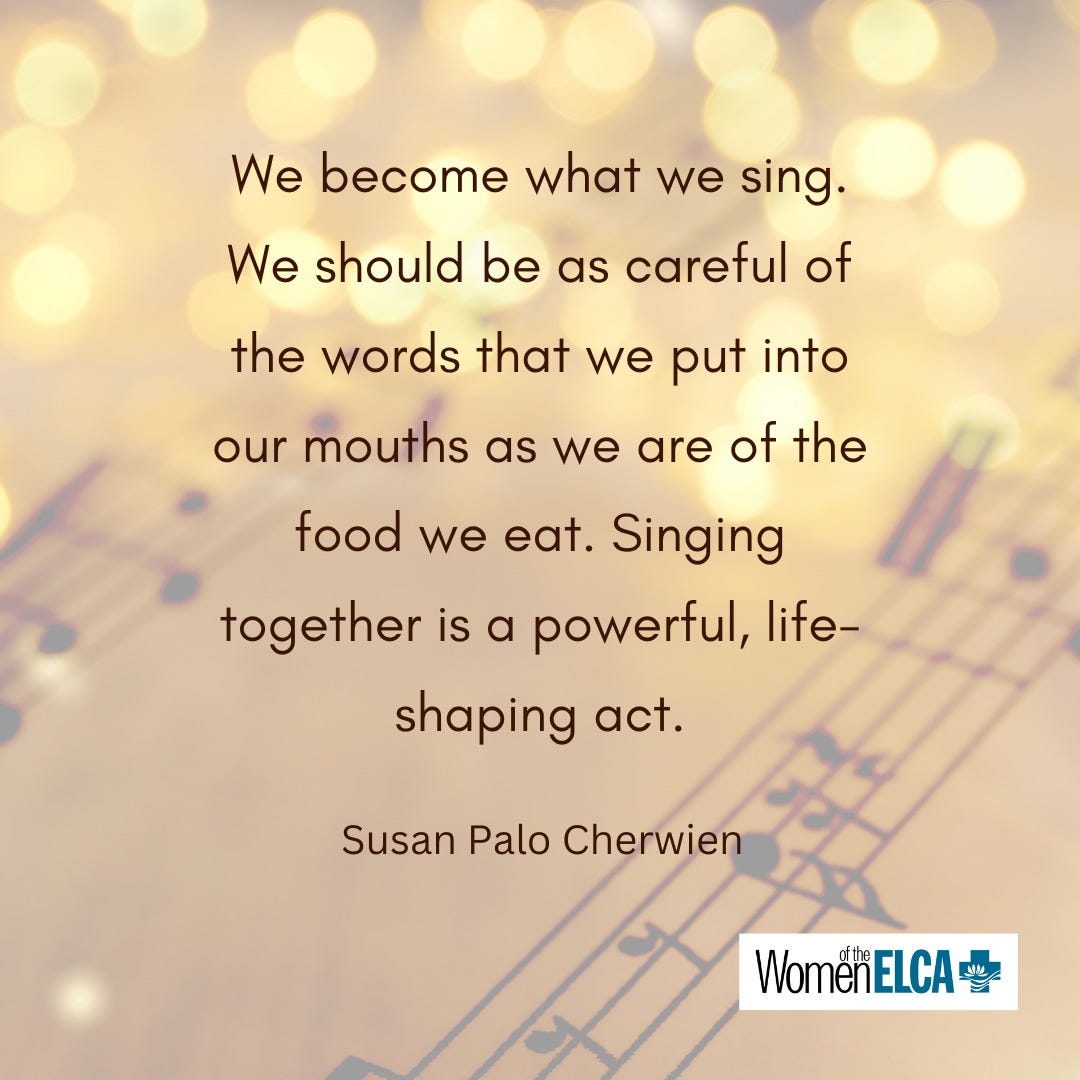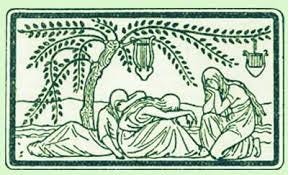What Happens When We Sing?
Creating an Altar of Song, Why We Remember, & More
Dear Friends –
(And hello to a whole new contingent! Welcome - I’m so glad you’re here!)
I’ve been unusually preoccupied by singing lately. And for all the writing I’ve done here about protest music over the years and all the songs I share, actually singing has always been something of a marginal hobby for me. I enjoy it, but I grew up being told that I couldn’t “carry a tune in a bucket.”
I’m not an extraordinary singer, but that statement is objectively untrue and took some undoing. So while I largely became a confident public speaker in high school (thanks science research presentations) I’ve spent my adulthood attempting to find some confidence in that aspect of my voice. One thing I’ve consistently observed, though, is how lovely it is to be with church people (broadly defined) sharing in simple song. It always sounds lovely, warm and full. And when the Godly Play trainer community was together a few weeks ago, we found ourselves in intensive conversation about singing, particularly about the power of singing in community.
Years ago, one member of our community said, they drew people’s blood in varying contexts. What did they find? That group singing produces one of the highest levels of oxytocin, which is the hormone associated with bonding and connection. As it turns out, there’s much more recent research support this, too. Singing together results in what has been termed the “ice breaker effect,” facilitates the feeling of belonging, an can even impact pain levels, self-confidence, and other important health metrics.
But what do we sing? What should we sing?
I came across this graphic the other day, which struck me in thinking about some of our traditional singing practices –
“We become what we sing. We should be careful of the words that we put into our mouths as we are of the food we eat. Singing together is a powerful, life-shaping act,” writes Susan Palo Cherwien, a Lutheran hymnwriter who died in 2021.
I have always said that I am particularly fond of song as prayer. I delight in finding new songs that draw me close to God. “Oh Lord” by Anointed Family is a recent addition to that roster –
Singing with Music that Makes Community anchors my week. Board member and one of my regional neighbors, Nancy Willbanks shares songs in her newsletter, All Our Days, including a brand new one that she wrote just for these times (and which she taught the Monday Morning Grounding community during our most recent weekly gathering). There is simply so much singing.
This past Sunday I taught the Godly Play story on Exile & Return and one of my favorite parts of that story is about what happened when the People of God were marched away from Jerusalem by the Babylonian army: they hung their harps on the willow trees and sang sad songs. Here was how they made their grief audible.
A Song For Joy, A Song For Grief
While I did start the resource line-up for Advent last week, I want to return us to the commemoration of All Saints for a moment as we enter the Allhallowtide Triduum.
Because of the nature of our days, All Saints and All Souls find themselves conflated – we read the necrology. We remember our own. And while you probably don’t have a song that stirs your heart to recall St. John the Evangelist or figures like that, you probably have one that reminds you of your grandfather or your mother or that dear friend. My grandfather wasn’t a churchgoing sort of character, for example, but he was a gardener and we sang “This Is My Father’s World” at his funeral. Mid-2000s Taylor Swift makes me think of my friend Brandon. “Brighter in the Dark” by Mouths of Babes makes me think of my friend Mona.
The classic and sometimes maligned hymn choice for All Saints is of course “I Sing a Song of the Saints of God,” as well as things like “For All the Saints, Who from Their Labors Rest,” but what are the songs that draw you close to practices of remembering the dead and to your own dead? If, instead of an altar of photos and prayer cards and memorabilia, we could bring a song to that altar of memory, what would you bring?
Will you build an altar with me?
In keeping with this space of remembering, I also want to lift up my friend and colleague Cheryl Minor’s remembrance of Jerome Berryman, founder of Godly Play, in the journal Religious Education.
I have been thinking about how to explain the Allhallowtide Triduum in the language of Godly Play. Turning toward the Circle of the Church Year, the story of Advent, and other liturgical stories, what I understand so far is this:
Remembering people who have died – people like saints, who are remembered for how very well they loved God and loved people – and people from our own lives, who we remember because we loved them and they loved us – is so important that the church set aside three special days for it. [Where I live] These days happen toward the end of the Green Growing Days. The days are getting colder and darker. Plants may begin to die. Animals seek warmer places or put away food for the winter. The church year is almost over, getting ready to begin again.
What happens during these three days?
On the first day, we prepare. People may pray and fast.
On the second day we remember saints or holy people. And on the third day, we remember people we know who have died. On either of these days, people may visit cemeteries, light candles, create altars, and read the names of those who have died. We do these things to honor those people and to help us remember them.
We use the color white in church during these three special days. This is also the color we use for funerals, when someone has died, and during Easter, when we remember the great mystery – how Jesus died but then he came back to us in a new way.
It’s a work in progress and part of something larger, but here we are. It is almost those days of remembering.
Resource Round-Up
Before we jump into Advent, a few recent highlights:
Building Faith published a valuable resource on Spiritual Care for Children after a Disaster. They’re also soliciting wisdom from the community on similar resources for older children and teens – reach out to them if you have or know of something like this!
One of the founders of liberation theology Gustavo Gutiérrez died this past week at the age of 96. Daneen Akers of Holy Troublemakers & Unconventional Saint has offered an adapted version of the accompanying curriculum lesson on Gutiérrez (written by Wendy Claire Barrie) for download so we can all share his extraordinary work with our communities.
Anyone who has worked with me in my coaching practice (or in person) knows that I am obsessed with my paper planner. After changing styles for a number of years, I’ve spent the last few loyally using a Passion Planner and I my Godly Play practitioner self was delighted by their recent email inviting readers to connect with their inner child by reengaging in play. It includes a link to the National Institute for Play and a “play personality” quiz, as well as a series of ideas for how to reconnect with that playful, child part of yourself, both on your own and with your family or friends.
Returning primarily to the Advent theme over here, some updates and planning resources:
There are two new seasonal Read*Pray*Wonder*Play guides available for Flyaway Books titles: The Night of His Birth by Katherine Paterson and Home by Another Way by Barbara Brown Taylor. Just scroll down to the related resources for each title or check out all the guides here.
Also from PCUSA, consider equipping your community with these simple Advent at Home Candle Lighting resources featuring scripture from Psalms of Wonder. It’s one of those “just right” feeling resources – it’s not too much so it won’t leave families feeling overwhelmed by where to begin, but it offers enough of an invitation to leave room for more engagement.
Everyday Godly Play’s Mess Makes Meaning podcast will turn one year old next month and I want to recommend a return to their first podcast with the theme “Presence over Presents” – it’s the perfect time to remind ourselves what being with each other looks like.
If you’re looking for a deeper option for your personal Advent practice or to offer to adults in your community, Abbey of the Arts is offering an online retreat, “To Be Is A Blessing,” with associated daily Advent practices led by Christine and John Valters Paintner and Sybil MacBeth (of Praying in Color). It’s a little pricy but it’s got separate pieces to encourage creative practices through the whole of Advent and an incredible list of guest teachers. Maybe it’s a gift you give yourself in the midst of all that holiday season hurrying.
That’s all for this week. Change your clocks this weekend so you’re not late for church and I’ll see you all next Tuesday.
Peace,
Bird





My mother directed our children's choir at church, so I have many songs (and a couple of musicals: Cool in the Furnace and Beauty and the Feast) that I associate with her. Dona Nobis Pacem is a favorite. During worship, when the first verse of a hymn was played as an introduction, my dad would always sing the first verse. I'd whisper, "DADDY! It's not time to sing yet!" and he would grin at me and say, "It's always time to sing!" I sing during the introduction of all the hymns now, in his honor.
Thank you, Bird, for the reminder of how music brings us together. Also, how music is a touchstone of remembrance. I appreciated the link to Spiritual Care for Children in Times of Disaster. We have Godly Play at our Sunday School hour. As the Director of Christian Education, I am wondering now about how to incorporate a closing song to their Sunday morning experience. Thank you for the treasure-trove of resources and reflections.
Have a blessed November.
Susan